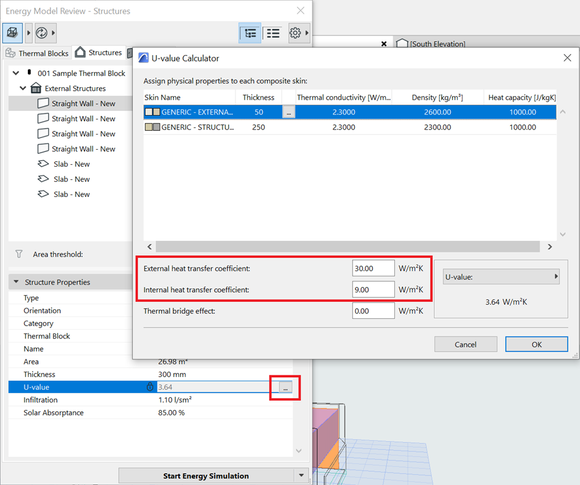- Graphisoft Community (INT)
- :
- Forum
- :
- Modeling
- :
- Re: Surface Heat Transfer
- Subscribe to RSS Feed
- Mark Topic as New
- Mark Topic as Read
- Pin this post for me
- Bookmark
- Subscribe to Topic
- Mute
- Printer Friendly Page
Surface Heat Transfer
- Mark as New
- Bookmark
- Subscribe
- Mute
- Subscribe to RSS Feed
- Permalink
- Report Inappropriate Content
2022-08-25 01:25 PM - edited 2022-08-25 01:25 PM
Hi! Can someone explain this parameter to me? I am not sure how to determine these coefficients and what they are used for in the Energy Evaluation tool. Aren't the specific U-values for the materials used when running an energy simulation?
I have read the explanation in the Archicad manual, but I am still confused as to how to calculate these or look for a local alternative.
Solved! Go to Solution.
Accepted Solutions
- Mark as New
- Bookmark
- Subscribe
- Mute
- Subscribe to RSS Feed
- Permalink
- Report Inappropriate Content
2022-09-01 04:18 PM
Hi @SidselVincents,
Yes, the U values for the materials are used when running the simulation. The Surface Heat Transfer values (under Environment Settings) are locked and should not be changed unless the local standards tell you to do so.
The Surface Heat Transfer coefficients (under Environment Settings) are not alternatives to the U values but to the external and internal heat transfer coefficients that are defined for each structure (vertical walls, horizontal flat roofs, tilted roofs, basement floors, etc.):
The external and internal heat transfer coefficients are defined by the country’s standards or building codes. These values should be entered in Archicad. An example:
When the U values are calculated, three physical processes are included:
- The heat conduction within the solid structure (within all its layers or skins)
- The heat convection between the structure and the air on the internal and the external surfaces of the structure
- The heat exchange by radiation between the structure and other “objects”
The external and internal heat transfer coefficients are pre-calculated in the local standards and they consider both the convection and the radiation happening on the internal and external surfaces.
It is possible that the default way of calculation (leaving the two boxes for Surface Heat Transfer locked) will provide you correct results according to local standards. As you most probably know calculation in EcoDesigner STAR is done according to the ASHRAE 90.1 standard, so if your local standard is based on this, that most probably you do not need to look for a local alternative.
Group Product Manager
Graphisoft
- Mark as New
- Bookmark
- Subscribe
- Mute
- Subscribe to RSS Feed
- Permalink
- Report Inappropriate Content
2022-08-25 03:50 PM
@Balint Kezer Regarding our earlier exchange I believe @SidselVincents has posed a question that no one here will answer. Can you or someone else at GS help so we can all learn?
- Mark as New
- Bookmark
- Subscribe
- Mute
- Subscribe to RSS Feed
- Permalink
- Report Inappropriate Content
2022-09-01 04:18 PM
Hi @SidselVincents,
Yes, the U values for the materials are used when running the simulation. The Surface Heat Transfer values (under Environment Settings) are locked and should not be changed unless the local standards tell you to do so.
The Surface Heat Transfer coefficients (under Environment Settings) are not alternatives to the U values but to the external and internal heat transfer coefficients that are defined for each structure (vertical walls, horizontal flat roofs, tilted roofs, basement floors, etc.):
The external and internal heat transfer coefficients are defined by the country’s standards or building codes. These values should be entered in Archicad. An example:
When the U values are calculated, three physical processes are included:
- The heat conduction within the solid structure (within all its layers or skins)
- The heat convection between the structure and the air on the internal and the external surfaces of the structure
- The heat exchange by radiation between the structure and other “objects”
The external and internal heat transfer coefficients are pre-calculated in the local standards and they consider both the convection and the radiation happening on the internal and external surfaces.
It is possible that the default way of calculation (leaving the two boxes for Surface Heat Transfer locked) will provide you correct results according to local standards. As you most probably know calculation in EcoDesigner STAR is done according to the ASHRAE 90.1 standard, so if your local standard is based on this, that most probably you do not need to look for a local alternative.
Group Product Manager
Graphisoft
- Mark as New
- Bookmark
- Subscribe
- Mute
- Subscribe to RSS Feed
- Permalink
- Report Inappropriate Content
2022-09-01 07:28 PM
@Balint Kezer Thank you for the explanation that is most useful and correlates with my recent findings.
- Mark as New
- Bookmark
- Subscribe
- Mute
- Subscribe to RSS Feed
- Permalink
- Report Inappropriate Content
2022-09-08 02:55 PM
Thank you so much for the clarification 🙂
- Dandelion 🚀 A revolutionized point-cloud-based modeler for Archicad 🚀 in Modeling
- Surface Heat Transfer in Modeling
- Building Together Challenge - Frequently Asked Questions (FAQ) in General discussions
- ArchiCAD Talk members Open Letter to Graphisoft in Modeling
- Element Transfer Settings for Cabinets in Libraries & objects



